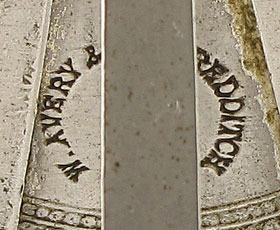Easel – Floral

Needle Case (nickel-plated version)

Design Representation
Design Details
Needle Case Type: |
Figural |
Patent/Registered to: |
Buncher & Haseler - Birmingham |
Patent/Design Representation #: |
Ornamental Class1: Metal: #292979 |
Patent/Design Registration Date: |
July 19, 1875 |
Location of Patent/Design Registration: |
The National Archives (TNA) - Kew, UK |
Reference #: |
TNA Representation - BT 43/38/292979
TNA Register - BT 44/3/292979 |
Dimensions: |
5.8 x .05 x 11.5 |
Material: |
Brass |
Name Variations: |
a) W. Avery & Son - Redditch
b) Baggallays, Westall & Spence - London
c) Cormack Bros. - London
d) J. & T. Forgie - Glasgow
e) Sydney J. Saunders - London
f) W. Whiteley - Westbourne Grove |
Other Variations: |
a) Nickel-plated version
b) Easel – Diamond Jubilee |
Additional Photographs


Front closed and open


Side and back views


Back signature detail and front floral basket detail (photos from eBay)


Back Cormack signature detail and Forgie signature detail (photos from eBay)


Back Whiteley signature detail (photo courtesy of David Chatterley) and brass version front detail (photo courtesy of Lynda Herrod)


Back Baggallays signature detail (photo from eBay) and Saunders signature detail (photo from the Internet)
Facts
The easel is a device designed to hold an artwork either for support while the painter works or for display purposes. A common
type is three legged with the back leg hinged to enable it to swing back to form a tripod. A horizontal cross bar on the front two
legs provides stability and support for the painting. Artist’s easels are typically wood and intended to be simple and
functional. Display easels however are frequently more ornate with style and materials chosen to complement the finished artwork
displayed for example carved and gilded easels.

History
Easels are known to have been used since ancient times and their basic design to have changed very little. Pliny the Elder, in his
encyclopaedic, 37 Volume Naturalis Historius (Natural history), published in 77AD, attempted a compilation of knowledge up to his
time. Art history is included and he makes reference to a panel prepared for painting on what must have been an easel in an account
of the contest of skill between Apelles and Protogenes, both renowned painters of ancient Greece. Easels were increasingly used from
the 13th century when smaller works replaced murals and during the Renaissance when painting on canvas became more popular than on
wood. Small portable easels enabled artists to leave the studio to paint landscapes.

Miscellaneous
The anecdote tells of Apelles travelling to Rhodes to meet Protogenes. Protogenes is out but he is shown by an old woman into his
studio where there is a large panel ready for painting. She asks who she should say has called and Apelles, renowned for his expert
drawing shills, walked to the easel and drew in coloured paint an extremely fine line across the panel, and told her to tell Protogenes
“this came from me”. On his return, Protogenes examined the line and realised only Apelles could have executed it. Using
another paint colour, he proceeded to draw an even finer line through the length of Apelles’ line. When Apelles returned and was
shown this by the woman, he was “ashamed” and in a third colour drew another line so fine that it couldn’t be bettered. This painting
was sent to Rome where it was reputedly greatly admired until destroyed when Julius Caesar’s mansion on Palatine Hill burnt down.
The painting below by Giovanni Battista Tiepolo is his take on Apelles painting Alexander the Great's mistress. Click on the photo
below to see a larger version of "Alexander the Great and Campaspe in the Studio of Apelles" painted in 1740.

Note: Right side panel text and photos provided by Lynda Herrod.





















